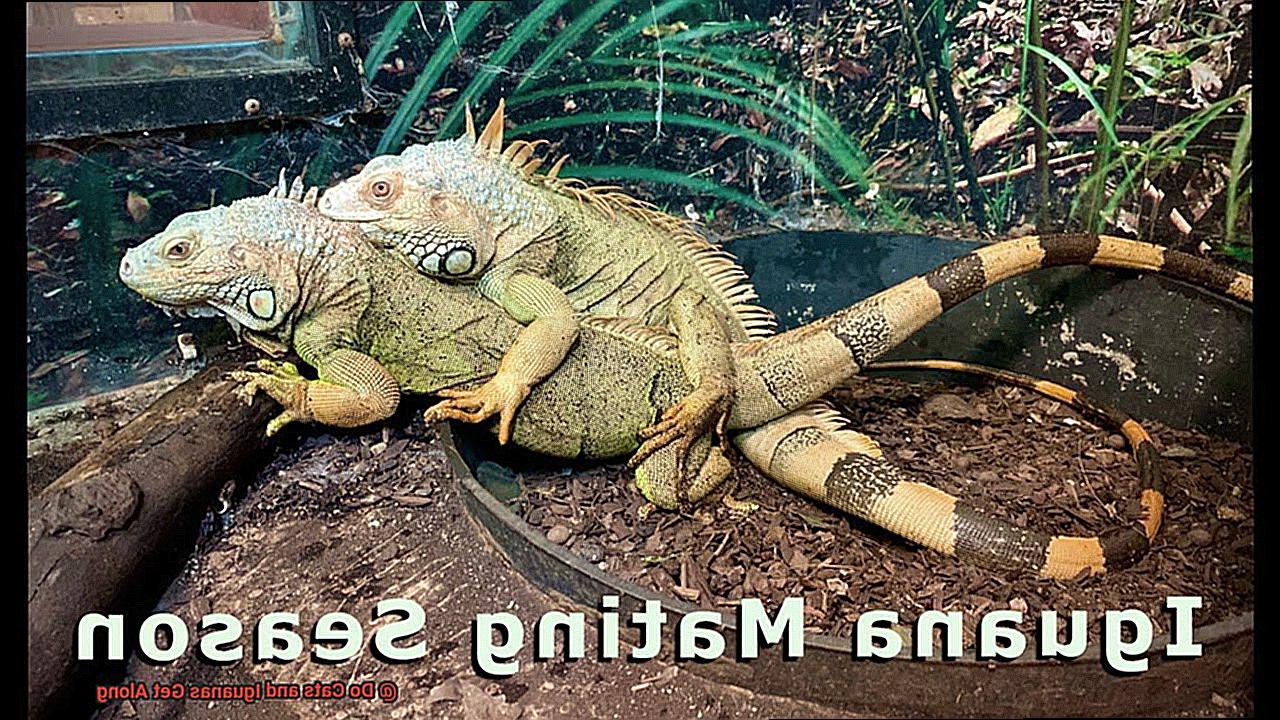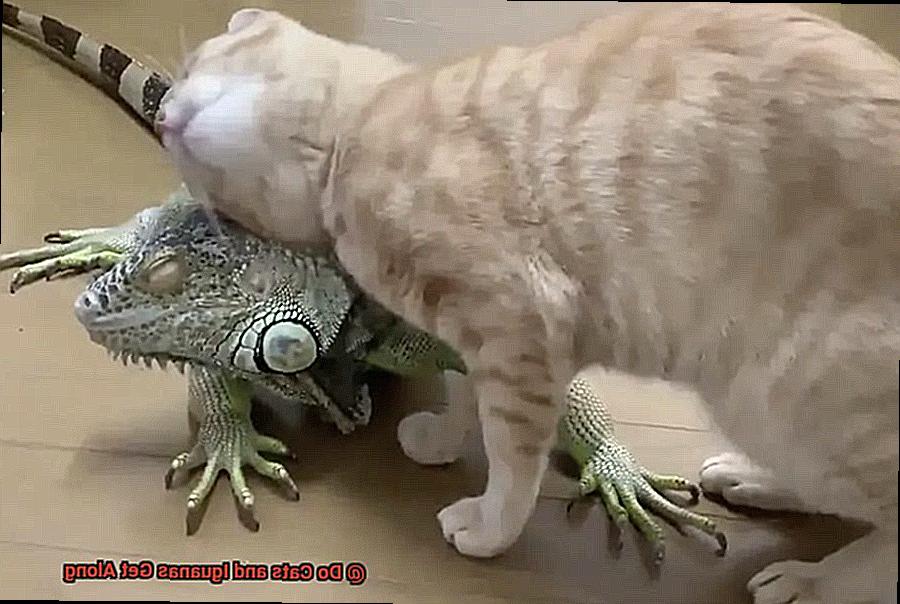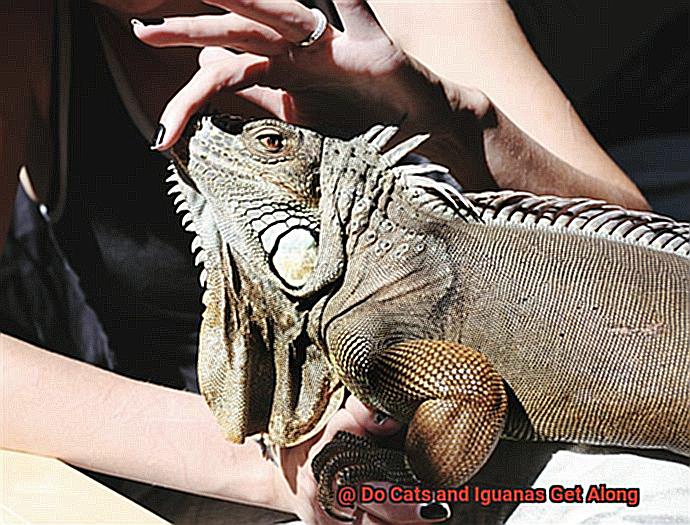Are you a cat person, an iguana enthusiast, or both? If so, you may be wondering if these two creatures can coexist peacefully. The question is: do cats and iguanas get along? The answer is not as straightforward as you might think.
Cats are known for their curious and playful nature, which can sometimes lead to aggression towards unfamiliar animals. Meanwhile, iguanas are generally calm and reserved. However, despite their seemingly different temperaments, both cats and iguanas are territorial creatures.
Before introducing your cat to your iguana (or vice versa), there are several things you need to consider. Compatibility between these animals is not guaranteed because their relationship depends on various factors such as age, gender, and size.
In this blog post, we’ll explore the topic of whether cats and iguanas can get along. We’ll delve into some of the myths surrounding this issue and provide practical tips on how to ensure a harmonious relationship between your feline friend and scaly buddy. So if you’re curious about the potential friendship between cats and iguanas, keep reading.
The Natural Instincts of Cats
Firstly, it’s important to note that cats are natural predators with an innate drive to hunt and kill small animals, including reptiles like iguanas. However, it’s worth mentioning that not all cats are the same – some may be more tolerant of other animals than others, depending on their unique personality and past experiences.
That being said, introducing a cat and an iguana should always be done gradually and with caution. Iguanas are generally docile creatures, but they can become aggressive if they feel threatened or stressed. If a curious or aggressive cat poses a threat to the iguana, it may lash out in self-defense.
To ensure a peaceful coexistence between your pets, you should provide each animal with their own separate space and resources. This means separate food bowls, litter boxes, and designated areas for each pet to relax in. Supervision is also crucial when they are together, especially during the initial introduction period.
It’s important to remember that cats are territorial animals who mark their territory by rubbing their scent on objects and surfaces. They may not take kindly to intruders like iguanas entering their space, so it’s best to introduce them slowly and monitor their interactions closely.
The Personality of Iguanas
Part of the reason for this is because iguanas are territorial animals that fiercely protect their space and resources. This means that they may become aggressive when they feel threatened by other animals invading their turf – including curious cats looking for a new playmate.
Another important aspect of an iguana’s personality is their sensitivity to stress. These creatures are easily stressed by changes in their environment, such as the introduction of new animals or people. This stress can lead to health problems and behavioral issues such as aggression towards other animals. So, introducing a cat into an iguana’s environment could cause unnecessary stress and lead to negative consequences.
While it is possible for cats and iguanas to coexist peacefully under certain circumstances, it is important to understand the potential risks and challenges involved in introducing these two very different animals. Careful introductions, separate spaces, and constant supervision are necessary to ensure their safety.
In conclusion, the personality of iguanas may not be well-suited for living with cats, but that doesn’t mean it’s impossible. As a responsible pet owner, it’s important to consider your pets’ individual needs and personalities before introducing them to each other.

Introducing a Cat and Iguana
Are you excited about welcoming an iguana into your home, but worried about how your cat will react? Introducing a cat and iguana can be a tricky process, but it’s definitely not impossible. As an expert, I’m here to guide you through the steps to ensure a successful and harmonious introduction.
Step 1: Keep Them Separated
The first step in introducing a cat and iguana is to keep them in separate rooms. This allows them to become familiar with each other’s scent without any direct contact. You can swap their bedding or use a pheromone spray to help them get used to each other’s smell. Also, make sure that the iguana’s enclosure is secure and cannot be accessed by the cat.
Step 2: Introduce Them in a Controlled Environment
Once they are comfortable with each other’s scent, you can start introducing them in a controlled environment. You can allow the cat to observe the iguana from a distance while on a leash or in a carrier. Ensure that you monitor their behavior closely and intervene when necessary.

Step 3: Be Cautious of Signs of Aggression
If the cat shows signs of aggression towards the iguana, such as hissing or swatting, it may be necessary to separate them again and start the introduction process over. Not all cats will get along with iguanas, so it’s essential to be cautious and patient throughout the process.
Step 4: Remember That Not All Cats and Iguanas Will Get Along
It’s important to remember that not all cats will get along with iguanas, and it may not be possible for them to coexist peacefully. If this is the case, it’s best to keep them separated for their own safety.
Introducing a cat and iguana requires patience, caution, and careful monitoring. With the right approach and a little bit of time, your cat and iguana can become the best of friends. Remember, these two animals are very different, with cats being natural predators and iguanas being prey animals. Handling them with care is vital to their safety and wellbeing.
Keeping the Pets Separately
If you’re contemplating adding an iguana to your home and already have a cat, it’s essential to understand the significance of keeping them separated. Although it may seem like a fun idea to have two different pets coexisting in harmony, the reality is that cats and iguanas have distinct needs and personalities that can clash and lead to unsafe situations.
One of the main reasons for keeping cats and iguanas separate is due to their natural instincts. Some cats may consider iguanas as prey and become aggressive towards them, while some iguanas may feel threatened by the presence of a cat and become stressed or anxious. This can result in injuries or even death for one or both pets.
To prevent any harm from occurring, it’s best to provide each pet with their own designated area of the home where they can feel comfortable and secure. For cats, this might mean a separate room or area of the house that is off-limits to the iguana. For iguanas, this might mean a terrarium or enclosure that is tall enough to prevent the cat from reaching them.

It’s crucial to monitor both pets when they are in the same room together, even if they are separated by a barrier. Cats are known for their agility and can jump over a low barrier or squeeze through a small opening. Iguanas may also be capable of escaping from their enclosure if it is not secure enough.
In addition to physical separation, providing each pet with their own food, water, and toys is critical. Cats should not be allowed to eat the iguana’s food or drink from their water dish as this can lead to health problems for both pets. Similarly, iguanas should not be allowed to play with cat toys or objects that may pose a choking hazard.
Keeping cats and iguanas separately is vital for their safety and well-being. Although it may seem disappointing at first, it’s better to be cautious and provide each pet with their own space and resources.
Providing Adequate Living Spaces
When it comes to cats and iguanas, there are a few things to keep in mind.
Firstly, iguanas are much larger than cats and need plenty of space to move around comfortably. Therefore, it’s imperative to provide a separate enclosure for your iguana. Additionally, these reptiles require specific environmental conditions, such as high humidity levels and warm temperatures, so their enclosure should be set up accordingly with specialized equipment like heat lamps, misting systems, and thermometers.
Your cat’s living space is equally important. Cats are curious and active animals that need lots of room to play and explore. Providing them with toys and scratching posts can help keep them entertained and mentally stimulated. Furthermore, cats should have a safe space where they can retreat if they feel stressed or overwhelmed – this could be a cozy bed or hideaway that is out of reach of your iguana.
By taking the time to set up separate enclosures for your pets and providing appropriate environmental conditions, you can ensure that both your cat and iguana are happy and healthy in their respective living spaces. Remember, each animal has its unique needs that should be considered when creating their living space.
SmlfwHabX3Y” >
Conclusion
In conclusion, the question of whether cats and iguanas can coexist peacefully is a complex one. While cats are known for their playful and curious nature, they can also exhibit aggression towards unfamiliar animals. On the other hand, iguanas are generally calm and reserved creatures. However, both cats and iguanas are territorial beings, which can lead to conflicts.
To ensure a harmonious relationship between your feline friend and scaly buddy, it’s crucial to consider various factors such as age, gender, and size before introducing them to each other. It’s important to keep in mind that cats have an innate drive to hunt and kill small animals like iguanas.
Therefore, introducing a cat and an iguana should always be done gradually and with caution. Providing each animal with their separate space and resources is crucial. Supervision is also necessary when they are together, especially during the initial introduction period.
It’s essential to understand that not all cats will get along with iguanas, and it may not be possible for them to coexist peacefully. Therefore, keeping them separately is vital for their safety and well-being.
By taking the time to set up separate enclosures for your pets and providing appropriate environmental conditions, you can ensure that both your cat and iguana are happy in their respective living spaces. Remember that each animal has its unique needs that should be considered when creating their living space.
In summary, while it’s possible for cats and iguanas to get along under certain circumstances, it’s essential to exercise caution when introducing them.







